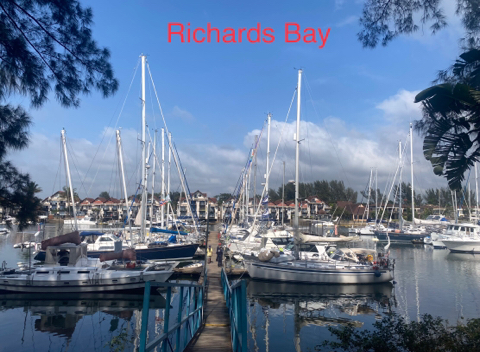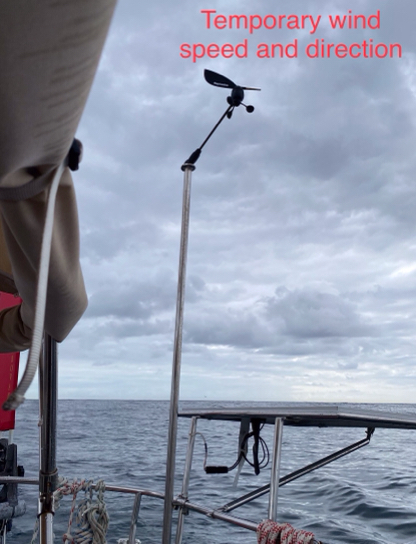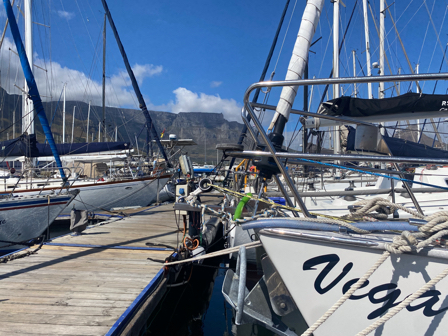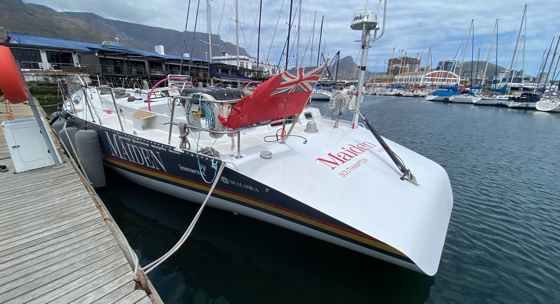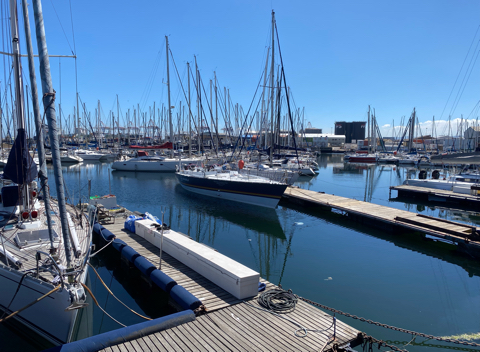Cape Town

33:55.178S 18:26.565E East London is home to the Buffalo River Yacht Club. The Commodore is Peter Sahd and he, Judy (bar, food and administration) and the other members extend a warm welcome to visiting yachties. With one long walk on pontoon and several trot moorings East London is the most likely stop for boats heading to Capetown after Richards Bay or Durban. The visitors book is a trip down memory lane for yachts that we have sailed with. South Africa’s only river port, East London is not the prettiest of locations. The yacht club is on the west side of the river, beneath the steel road bridge across to the town on the east side. It is considered safe to walk outside the marina but to cross the bridge is to invite near certain mugging, beating or worse. For all that the town was considered relatively safe by our taxi drivers and unlike other towns and cities you can drive with the car windows open. The Yacht Club is a safe haven from which a taxi is required even to the nearest shops. We took one to the Nahoon Estuary Nature reserve and had a lovely walk past cliffs, through woods and mangrove and across the beach. The cliff tops were lined with palatial glass fronted houses enjoying the view over the estuary. There are (to us anyway) a surprisingly large number of solo sailors circumnavigating. As Jonathan Raban so eloquently wrote in his book “Coasting” solo sailors can be eccentric social outcasts or refugees. We met one of these at Buffalo River. “Pedro” as he is known is an American who lived in Mexico for 40 years. Larger than life and very engaging Pedro has amazing tales of a rumbustuous upbringing in Louisiana and Mexico and Viking ancestry that stretches back through the famous saga families. Wonderful entertainment over a few beers but belying family scars and a deep disenchantment with world politics. Pedro was concerned about his engine that he would work on once at Saldanha Bay, his next port of call and which is north of Capetown. The engine failed in thick sea mist with no wind and the maritime rescue service towed Pedro to a safe anchorage where he awaits the right wind to complete his passage to Saldanha. On the same day another solo sailor was towed into Capetown, also with engine failure. Our own passage down the “wild coast” and past the Cape of Storms was less eventful. We made a fast passage from East London, initially close hauled with a light south easterly wind and then a long period of motoring when the wind faded. We came 40 plus miles to the south of the coast to keep in the strong west flowing current. By then we were sailing again but needed the engine to give us enough speed through the water to get out of the current before being swept down to the south. At this point we were heading west with enough wind for a genoa run past Cape Aghulas. With surprising regularity we had to alter course to avoid floating tree branches that we could see sticking up from the sea. On closer examination it turned out that these branches were in fact fur seals asleep on their backs with front and tail fins held up out of the water! Sitting targets for the Great Whites? There is a lot of commercial shipping along this coast. Also gas fields with shipping lanes in places to keep the two apart. We skirted the shipping lanes with a steady stream of ships coming up from behind and passing a mile or less to one side. A mile may sound a lot but from five miles astern it may not be clear which side the mile will be and we often call up a ship to make sure it is both aware of us and happy for us to hold our course. Usually this results in a pleasant exchange of courtesy’s and provides a bit of light relief for both yacht and ship. Furthermore with our new more powerful AIS we can be detected at a greater distance than previously. One night we had a large Chinese fishing vessel coming up from behind on a collision course. Like us he was clearly keeping to the edge of the shipping lane and appeared to be taking no avoiding action. I had to call repeatedly on the radio before getting a response that was “sorry, speak no English”. Really helpful so I hoped he would get the gist by my strongly urging him to keep clear (an overtaking vessel has to keep clear of the vessel being overtaken). This seemed to do the trick and he altered course to pass half a mile off our port side. Our encounters with solo sailors and engine failure continued on this passage. We picked up a merchant vessel showing as “not under command” on the AIS. This doesn’t mean that the captain had jumped ship but that it was drifting and unable to manoeuvre having suffered engine failure. Close by this AIS target was another - that of yacht Ceres, a Halberg Ramsey 34 sailed by lone sailor Henry. Henry is in his late 70’s and a little hard of hearing. The stricken merchant vessel called Henry on the radio several times, clearly to warn him of its predicament and to ask him to keep clear but there was no reply from Henry. As the ship and yacht AIS targets merged on our screen we kept our fingers crossed that Henry was aware of the situation. Eventually and to our relief the targets diverged again and all was well. Faced with shared challenges yachties form a bond that is one of the abiding and heart warming consequences of long distance cruising. On the final night of this passage we had to keep our speed down so as to pass the Cape of Good Hope in daylight and get a view. The wind died as predicted before switching to the north east. What we hadn’t anticipated was the thick sea mist that often results from a warm northerly airflow blowing over the cold water coming up from the Antarctic. Fortunately this cleared in time for us to get a glimpse of the, well, underwhelmingly spectacular Cape. It is a low peninsular extending from the higher land running up the coast. At this point sailing seemed a possibility but the south setting current and close hauled angle meant a slow run up to Cape Town so we furled the sails and motored into the increasingly strong wind and choppy sea. For a while we could barely make 4kts with a 20kt headwind and it was all getting a bit slow and tedious. Should we go across into Hout Bay for the night? However, less wind, more engine revs and a turn to the north east after Hout Bay got us to over 5kts and a faster run up to Cape Town. In fact we then had to slow down after the sea mist set in again and visibility fell to around 50m. Fortunately the local fishing boats all seem to use AIS and we could monitor these and the larger commercial ships. When we arrived at the outer breakwater to the harbour the mist cleared enough to allow us to see where we were going across to the Royal Cape Yacht Club in the far corner. The wind had died and we would be met by the berthing manager in his boat and guided to our berth. The moment we entered the marina the wind suddenly picked up from behind and it was like being in a wind tunnel. Staff and yachties were waiting for us on a temporary berth on our starboard side that we would approach downwind. However, the wind was so strong we were being blown past and onto the main pontoon at right angles to our berth. Rather than plough into the main pontoon I steered away and continued into the marina, trying to turn around in the gap between each of the pontoons. The combination of the wind and the action of the locked Hydrovane rudder meant we couldn’t achieve enough steerage to make the turn. The end wall of the marina loomed but fortunately berthing manager Elliot realised what was happening and came to our rescue by using his dinghy to push our bow hard around and into the wind. We could then motor back to the berth and atone for my initial error by gently ferry gliding alongside. The following morning we came round to our intended berth from where we have been enjoying the comforts of the Royal Cape. This is the centre of yacht racing in South Africa. The facilities are great and with walls lined with cabinet trophies full of silverware there is a feel of both history and continuity. The yacht Maiden is here undergoing a refit. Maiden was made famous when raced around the world by Ellen MacArthur with an all female crew, some of whom are now top solo racers. Maiden is used by Ellen’s charitable foundation to promote sailing for women around the world. The other iconic yacht here is of course Vega. Actually there are two Vegas but the one we are concerned with is a polished thing of beauty that has brought us safely down the Mozambique Channel, along the wild coast and past the Cape of Storms. We came into RCYC with the specific purpose of having the mast removed in order to fit a new wind instrument cable. Whilst there I thought I would see if anyone could fix the drive pin in the Hydrovane (the retaining grub screw has seized), make a retaining block to stop the anchor rattling on the bow roller on passage, fit a replacement LED port navigation light, make a spacing collar for the new flag pole (having wrongly assumed that flag poles would be a standard diameter for the rail socket) and fit the new battery charger if it ever turns up (one was lost in the post and the second seems to be suffering a similar fate). They can and all is in hand! Furthermore having waited until Monday to have the mast removed we were bumped off the schedule back to Tuesday lunch time by an Oyster that had been waiting for spare parts that arrived that morning. I was flying back to the UK on Wednesday so it looked like Annie would have to get the boat over to the V&A Waterfront Marina after I had left. However, on Tuesday morning André and two colleagues arrived to see if they could manage the job without removing the mast. They seemed very knowledgeable and confident and I sceptically let them get on with it. Two hours later the job was done! On Tuesday afternoon we moved over to the V&A where all the other boats we know are and where Annie will be better placed within safe walking distance of the Waterfront shops, restaurants, galleries, public transport and so forth. It is the very upmarket side of town all around the marina. The guys doing the jobs on Vega work there as well and Annie will be able to manage this while I am in the UK. All very swish but my heart is at the RCYC where it is a bustle of yacht activity, racing and so forth and incredibly cheap by comparison! |
